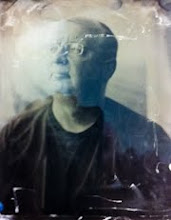Double Vision
(my first wet plate tintype)
Tintypes and Ambrotypes from Day 1
It's the day after the workshop, and I confess I'm totally in love with wet plate. And with Joni and her assistant Lisa. I've taken quite a few workshops over the years, and this one was without doubt the best I've ever taken. And in terms of the group of students, definitely in the top 3 of the various groups I've been part of. High level of interest, energy and excitement combined with a great cooperative spirit (important when sharing 2 cameras and 1 darkroom between 9 students), with a wonderful mix of ages and experience.
Elissa Marie self-portrait
Candace - self-portrait
Ottilie - self-portrait (zombie)
tied for the "Sally Mann" award
Lindsay - self-portrait
I think the experience we all had with the wet plate process is perfectly summed up by Lindsay, who posted a photo of her first wet plate result on facebook with the comment "I think I just died and went to heaven like 50 times over and over again. self portrait ambrotype!" I felt pretty much exactly the same.
Susie - self-portrait tintype
Richard - self-portrait tintype
Every student had successful plates, which given the complexities of the process, the chaotic nature of a workshop environment and the two day duration is quite an achievement. All possible because the course was well organized, and both Joni and Lisa are patient, generous teachers who shared their amazing knowledge of wet plate through clear instruction and with a good dose of humour.
Joni exposing the first plate of the workshop
David, Elissa and Ottilie look at the first plate with Joni
The first plate - David, self-portrait
In her book "Mindful Learning", Ellen Langer, a Harvard professor makes the case that students learn more effectively when they are presented with information in shades of grey rather than a cut and dried black or white approach. In any other wet plate workshop of such short duration, students would stick to making plates on trophy tin which doesn't need to be prepared in advance and is slightly easier to work with. And there is a strong argument to be made for such a "KISS" approach to teaching a process like wet plate.
Joni repairing a tear on a plate
Joni and Ottilie discussing equipment options
What was great about our workshop was the built-in "shades of grey": we were exposed to the ideas and working methods of two instructors; we worked in groups of three and could see how each student coped differently with the plate pouring and processing steps; we were encouraged to work with both tin and glass plates to get a range of experiences. I think these design details of the workshop really accentuated the learning process along the lines that Langer describes in her book. And by working not just with tin, we were confronted with problems with emulsion pealing, and making decisions about exposure and developer dilution in deciding between making a positive or negative ambrotype that lead to discussions of what went wrong and how to possibly solve it.
My second tintype - channeling René Descartes
One unexpected fun thing for me was discovering that I like taking portraits. I'm still not crazy about my own self-portraits, although I do like the way wet plate self-portraits look. Gave me new understanding of Chuck Close's longtime fascination with his own self-portrait. We worked in teams of three, so I had a chance to compose and focus selfportraits for both David and Shannon. There's something very breathtaking when you see the image on the ground glass come up with the sharp focus on the subject's eyes.
I have one additional plate, a clear glass ambrotype exposed to be used as a negative. I'm going to make some prints with it, and will post those results later.
Finally, I have to laugh at myself and a case of caveat emptor. During the meet and greet the first night, when we were each introducing ourselves and saying a little bit about why we were interested in wet plate, I specifically mentioned liking the accidental defects that can happen. As it turned out, I ended up with everything I had asked for (and more). My first plate ended up being double exposed because we were testing a camera and the shutter malfunctioned. I do like the double image. My second plate had quite a journey - it fell off the dipper when I was removing it from the silver tank, and Lisa had to work some magic to get it out, but the plate suffered a scratch (that ended up right across the top of my head in the end). After development (a perfect exposure), the plate had a few oyster shells. Joni was helping me remove them with a small piece of cotton ball, but a bit more emulsion was lifted off than should have happened (around the forehead/eye area). So I have a great plate with "additions" by Lisa and Joni - a keepsake for sure. And my ambrotype negative had a bit of peeling, so I have my own version of a "zombie" plate.
To sum up: the workshop was massive fun, I definitely will set up to do wet plate on my own, and if you ever have a chance to take a workshop with Joni Sternbach - do it!















2 comments:
After reading this comprehensive recap, I am now chomping at the bit to try this process. Guess I'll add it to my ever growing list.
This sounds amazing - I'm so delighted for you! And inspired to try this ... although still pulled between technique and content :-)
Post a Comment